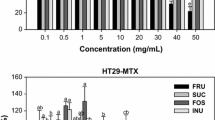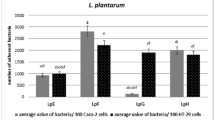Abstract
The aims of this study were to examine long-term growth interactions of five probiotic strains (Lactobacillus casei 01, Lactobacillus plantarum HA8, Lactobacillus rhamnosus GG, Lactobacillus reuteri ATCC 55730 and Bifidobacterium lactis Bb12) either alone or in combination with Propionibacterium jensenii 702 in a co-culture system and to determine their adhesion ability to human colon adenocarcinoma cell line Caco-2. Growth patterns of probiotic Lactobacillus strains were not considerably affected by the presence of P. jensenii 702, whereas lactobacilli exerted a strong antagonistic action against P. jensenii 702. In the co-culture of Bif. lactis Bb12 and P. jensenii 702, a significant synergistic influence on growth of both bacteria was observed (P < 0.05). The results of adhesion assay showed that when probiotic strains were tested in combination, there was evidence of an associated effect on percentage adherence. However, in most cases these differences were not statistically significant (P < 0.05). Adhesion percentage of Lb. casei 01 and Lb. rhamnosus GG both decreased significantly in the presence of P. jensenii 702 compared to their adhesion levels when alone (P < 0.05). These results show that the survival and percentage adhesion of some probiotic strains may be influenced by the presence of other strains and this should be considered when formulating in the probiotic products.



Similar content being viewed by others
References
Alander M, Satokari R, Korpela R, Saxelin M, Vilpponen-Salmela T, Mattila-Sandholm T, von Wright A (1999) Persistence of colonization of human colonic mucosa by a probiotic strain, Lactobacillus rhamnosus GG, after oral consumption. Appl Environ Microbiol 65(1):351–354
Arihara K, Ogihara S, Mukai T, Itoh M, Kondo Y (1996) Salivacin 140, a novel bacteriocin from Lactobacillus salivarius subsp. salicinius T140 active against pathogenic bacteria. Lett Appl Microbiol 22(6):420–424
Beachey EH (1981) Bacterial adherence: adhesin-receptor interactions mediating the attachment of bacteria to mucosal surface. J Infect Dis 143(3):325–345
Bougle D, Roland N, Lebeurrier F, Arhan P (1999) Effect of propionibacteria supplementation on fecal bifidobacteria and segmental colonic transit time in healthy human subjects. Scand J Gastroenterol 34(2):144–148
Brink M, Todorov SD, Martin JH, Senekal M, Dicks LMT (2006) The effect of prebiotics on production of antimicrobial compounds, resistance to growth at low pH and in the presence of bile, and adhesion of probiotic cells to intestinal mucus. J Appl Microbiol 100(4):813–820
Castellano P, Belfiore C, Fadda S, Vignolo G (2008) A review of bacteriocinogenic lactic acid bacteria used as bioprotective cultures in fresh meat produced in Argentina. Meat Sci 79(3):483–499
Collado MC, Meriluoto J, Salminen S (2007) Development of new probiotics by strain combinations: is it possible to improve the adhesion to intestinal mucus? J Dairy Sci 90(6):2710–2716
FAO/WHO (2001) Evaluation of health and nutritional properties of powder milk with live lactic acid bacteria. FAO/WHO, Cordoba, Argentina
FAO/WHO (2001) Report on joint FAO/WHO expert consultation on evaluation of health and nutritional properties of probiotics in food including powder milk with live lactic acid bacteria. FAO/WHO, Cordoba, Argentina
Frohlich-Wyder MT, Bachmann HP, Casey MG (2002) Interaction between propionibacteria and starter/non-starter lactic acid bacteria in Swiss-type cheeses. Lait 82(1):1–15
Gardner N, Champagne CP (2005) Production of Propionibacterium shermanii biomass and vitamin B12 on spent media. J Appl Microbiol 99(5):1236–1245
Gonzalez B, Arca P, Mayo B, Suarez JE (1994) Detection, purification, and partial characterization of plantaricin C, a bacteriocin produced by a Lactobacillus plantarum strain of dairy origin. Appl Environ Microbiol 60(6):2158–2163
Hojo K, Yoda N, Tsuchita H, Ohtsu T, Seki K, Taketomo N, Murayama T, Iino H (2002) Effect of ingested clture of Propionibacterium freudenreichii ET-3 on fecal microflora and stool frequency in healthy females. Biosci Microflora 21:115–120
Huang Y, Adams MC (2003) An in vitro model for investigating intestinal adhesion of potential dairy propionibacteria probiotic strains using cell line C2BBe1. Lett Appl Microbiol 36(4):213–216
Hugenholtz J, Hunik J, Santos H, Smid E (2002) Nutraceutical production by propionibacteria. Lait 82(1):103–112
Jan G, Belzacq AS, Haouzi D, Rouault A, Metivier D, Kroemer G, Brenner C (2002) Propionibacteria induce apoptosis of colorectal carcinoma cells via short-chain fatty acids acting on mitochondria. Cell Death Differ 9(2):179–188
Jimenez-Diaz R, Rios-Sanchez RM, Desmazeaud M, Ruiz-Barba JL, Piard JC (1993) Plantaricins S and T, two new bacteriocins produced by Lactobacillus plantarum LPCO10 isolated from a green olive fermentation. Appl Environ Microbiol 59(5):1416–1424
Kaneko T (1999) A novel bifidogenic growth stimulator produced by Propionibacterium freudenreichii. Biosci Microflora 18(2):73–80
Kaneko T, Mori H, Iwata M, Meguro S (1994) Growth stimulator for bifidobacteria produced by Propionibacterium freudenreichii and several intestinal bacteria. J Dairy Sci 77(2):393–404
Kaneko T, Noda K (1996) Bifidogenic growth stimulator produced by propionibacteria. Jpn J Dairy Food Sci 45(4):A83–A90
Kouya T, Misawa K, Horiuchi M, Nakayama E, Deguchi H, Tanaka T, Taniguchi M (2007) Production of extracellular bifidogenic growth stimulator by anaerobic and aerobic cultivations of several propionibacterial strains. J Biosci Bioeng 103(5):464–471
Lan A, Bruneau A, Bensaada M, Philippe C, Bellaud P, Rabot S, Jan G (2008) Increased induction of apoptosis by Propionibacterium freudenreichii TL133 in colonic mucosal crypts of human microbiota-associated rats treated with 1, 2-dimethylhydrazine. Br J Nutr 100(6):1251–1259
Lan A, Lagadic-Gossmann D, Lemaire C, Brenner C, Jan G (2007) Acidic extracellular pH shifts colorectal cancer cell death from apoptosis to necrosis upon exposure to propionate and acetate, major end-products of the human probiotic propionibacteria. Apoptosis 12(3):573–591
Lehto EM, Salminen S (1997) Adhesion of two Lactobacillus strains, one Lactococcus and one Propionibacterium strain to cultured human intestinal Caco-2 cell line. Biosci Microflora 16:13–17
Malik AC, Reinbold GW, Vedamuthu ER (1968) An evaluation of the taxonomy of Propionibacterium. Can J Microbiol 14(11):1185–1191
Michel C, Roland N, Lecannu G, Hervte C, Avice JC, Rival M, Cherbut C (2005) Colonic infusion with Propionibacterium acidipropionici reduces severity of chemically-induced colitis in rats. Lait 85(1–2):99–111
Mitsuyama K, Masuda J, Yamasaki H, Kuwaki K, Kitazaki S, Koga H, Uchida M, Sata M (2007) Treatment of ulcerative colitis with milk whey culture with Propionibacterium freudenreichii. J Intest Microbiol 21:143–147
Mori H, Sato Y, Taketomo N, Kamiyama T, Yoshiyama Y, Meguro S, Sato H, Kaneko T (1997) Isolation and structural identification of bifidogenic growth stimulator produced by Propionibacterium freudenreichii. J Dairy Sci 80(9):1959–1964
Mourad K, Halima ZK, Nour-Eddine K (2005) Detection and activity of plantaricin OL15 a bacteriocin produced by Lactobacillus plantarum OL15 isolated from Algerian fermented olives. Grasas Y Aceites 56(3):192–197
Munoa FJ, Pares R (1988) Selective medium for isolation and enumeration of Bifidobacterium spp. Appl Environ Microbiol 54(7):1715–1718
Okkers DJ, Dicks LM, Silvester M, Joubert JJ, Odendaal HJ (1999) Characterization of pentocin TV35b, a bacteriocin-like peptide isolated from Lactobacillus pentosus with a fungistatic effect on Candida albicans. J Appl Microbiol 87(5):726–734
Ouwehand AC (2004) The probiotic potential of Propionibacteria. In: Salminen S, von Wright A, Ouwehand AC (eds) Lactic acid bacteria: microbiological and functional aspects. Marcel Dekker Inc, New York, pp 159–174
Ouwehand AC, Suomalainen T, Tolkko S, Salminen S (2002) In vitro adhesion of propionic acid bacteria to human intestinal mucus. Lait 82(1):123–130
Parker JA, Moon NJ (1982) Interactions of Lactobacillus and Propionibacterium in mixed culture. J Food Prot 45(4):326–330
Perez Chaia A, Zarate G, Oliver G (1999) The probiotic properties of propionibacteria. Lait 79(1):175–185
Perez Chaia A, deMacias MEN, Oliver G (1995) Propionibacteria in the gut: effect on some metabolic activities of the host. Lait 75(4–5):435–445
Perez Chaia A, Strasser de Saad AM, de Ruiz Holgado AP, Oliver G (1995) Short-chain fatty acids modulate growth of lactobacilli in mixed culture fermentations with propionibacteria. Int J Food Microbiol 26(3):365–374
Perez Chaia A, Strasser de Saad AM, de Ruiz Holgado AP, Oliver G (1994) Competitive inhibition of Propionibacterium acidipropionici by mixed culturing with Lactobacillus helveticus. J Food Prot 57(4):341–344
Piveteau PG, O’Callaghan J, Lyons B, Condon S, Cogan TM (2002) Characterisation of the stimulants produced by Lactobacillus helveticus in milk for Propionibacterium freudenreichii. Lait 82(1):69–80
Piveteau P (1999) Metabolism of lactate and sugars by dairy propionibacteria: a review. Lait 79(1):23–41
Rogosa M, Mitchell JA, Wiseman RF (1951) A selective medium for the isolation and enumeration of oral and fecal lactobacilli. J Bacteriol 62(1):132–133
Satomi K, Kurihara H, Isawa K, Mori H, Kaneko T (1999) Effects of culture-powder of Propionibacterium freudenreichii ET-3 on fecal microflora of normal adults. Biosci Microflora 18:27–30
Servin AL, Coconnier MH (2003) Adhesion of probiotic strains to the intestinal mucosa and interaction with pathogens. Best Pract Res Clin Gastroenterol 17(5):741–754
Tuomola EM, Ouwehand AC, Salminen SJ (1999) Human ileostomy glycoproteins as a model for small intestinal mucus to investigate adhesion of probiotics. Lett Appl Microbiol 28(3):159–163
Uchida M, Yoda N, Hojo K (2005) Efficacy of the bifidogenic growth stimulator (BGS) produced by Propionibacterium freudenreichii ET-3. Foods Food Ingred J Jpn 210(12):1132–1140
van Reenen CA, Dicks LM, Chikindas ML (1998) Isolation, purification and partial characterization of plantaricin 423, a bacteriocin produced by Lactobacillus plantarum. J Appl Microbiol 84(6):1131–1137
Warminska-Radyko I, Laniewska-Moroz L, Babuchowski A (2002) Possibilities for stimulation of Bifidobacterium growth by propionibacteria. Lait 82(1):113–121
Zarate G, Perez Chaia A, Gonzalez S, Oliver G (2000) Viability and beta-galactosidase activity of dairy propionibacteria subjected to digestion by artificial gastric and intestinal fluids. J Food Prot 63(9):1214–1221
Zarate G, Morata De Ambrosini V, Perez Chaia A, Gonzalez S (2002) Some factors affecting the adherence of probiotic Propionibacterium acidipropionici CRL 1198 to intestinal epithelial cells. Can J Microbiol 48(5):449–457
Zarate G, Morata De Ambrosini V, Perez Chaia A, Gonzalez SN (2002) Adhesion of dairy propionibacteria to intestinal epithelial tissue in vitro and in vivo. J Food Prot 65(3):534–539
Acknowledgements
The authors are grateful to Mr Dave Phelan (SEM unit, The University of Newcastle, Australia) for his assistance with the electron microscopy. They would also like to thank Dr. Matthias Ernst (Ludwig Institute in Melbourne, Australia) for kindly providing the Caco-2 cell line and Mr. Kim Colyvas (Statistical Support Service, The University of Newcastle, Australia) for advice and assistance with statistical analysis of data.
Author information
Authors and Affiliations
Corresponding author
Rights and permissions
About this article
Cite this article
Moussavi, M., Adams, M.C. An In Vitro Study on Bacterial Growth Interactions and Intestinal Epithelial Cell Adhesion Characteristics of Probiotic Combinations. Curr Microbiol 60, 327–335 (2010). https://doi.org/10.1007/s00284-009-9545-1
Received:
Accepted:
Published:
Issue Date:
DOI: https://doi.org/10.1007/s00284-009-9545-1




